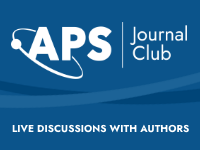| Volume 95, Issue 4 (partial) October - December 2023  | On the Cover Atmospheric nanoparticles can serve as nuclei for cloud droplets, thereby inducing significant but uncertain effects on the radiative forcing of the climate system. This article focuses on the physicochemical processes that govern the growth of these particles from formation of molecular clusters until the particles reach sizes where they can act as cloud condensation nuclei. The review describes the latest developments in measurement and modeling of these processes and connects these domains to the large-scale simulations such as Earth system models. The authors recommend closer coordination among laboratory studies, atmospheric measurements, and large-scale modeling to understand the importance of nanoparticles in the climate system. From the article Atmospheric nanoparticle growth
Dominik Stolzenburg, Runlong Cai, Sara M. Blichner, Jenni Kontkanen, Putian Zhou, Risto Makkonen, Veli-Matti Kerminen, Markku Kulmala, Ilona Riipinen, and Juha Kangasluoma
Rev. Mod. Phys. 95, 045002 (2023) | | | |
Advertisement | The APS Committee on the Status of Women in Physics (CSWP) is now accepting proposals from undergraduate and graduate students who are interested in creating new WiP groups or enhancing existing ones. The deadline for proposals is January 26, 2024. Learn more. | | | | | | Not an APS member? Join today to start connecting with a community of more than 50,000 physicists. | | | | Featured in Physics Mira L. Pöhlker, Christopher Pöhlker, Ovid O. Krüger, Jan-David Förster, Thomas Berkemeier, Wolfgang Elbert, Janine Fröhlich-Nowoisky, Ulrich Pöschl, Gholamhossein Bagheri, Eberhard Bodenschatz, J. Alex Huffman, Simone Scheithauer, and Eugene Mikhailov Rev. Mod. Phys. 95, 045001 (2023) – Published 12 October 2023  | The pandemic of coronavirus disease 2019 has led to a renewed focus on the physicochemical properties of the droplets and aerosol particles that are exhaled during breathing, speaking, singing, coughing, and sneezing. In this article, the properties of respiratory particles, including their number concentrations and size distributions, as well as their formation mechanisms at different sites in the respiratory system, are reviewed. The data in the literature are synthesized via a parametrization of the particle size distribution data using log-normal modes related to the different origin sites. | | | | | | Dominik Stolzenburg, Runlong Cai, Sara M. Blichner, Jenni Kontkanen, Putian Zhou, Risto Makkonen, Veli-Matti Kerminen, Markku Kulmala, Ilona Riipinen, and Juha Kangasluoma Rev. Mod. Phys. 95, 045002 (2023) – Published 9 November 2023  | Atmospheric nanoparticles can serve as nuclei for cloud droplets, thereby inducing significant but uncertain effects on the radiative forcing of the climate system. This article focuses on the physicochemical processes that govern the growth of these particles from formation of molecular clusters until the particles reach sizes where they can act as cloud condensation nuclei. The review describes the latest developments in measurement and modeling of these processes and connects these domains to the large-scale simulations such as Earth system models. The authors recommend closer coordination among laboratory studies, atmospheric measurements, and large-scale modeling to understand the importance of nanoparticles in the climate system. | | | | | | Kevin Vynck, Romain Pierrat, Rémi Carminati, Luis S. Froufe-Pérez, Frank Scheffold, Riccardo Sapienza, Silvia Vignolini, and Juan José Sáenz Rev. Mod. Phys. 95, 045003 (2023) – Published 15 November 2023  | The study of optics in correlated disordered media combines wave physics, complex media, and nanophotonics. Investigations have shown how subwavelength structural correlations control light scattering, transport, and localization. This article reviews the formalism behind light scattering in disordered media, experimental techniques, and achievements in studying light interaction with correlated disorder. It explores phenomena like optical transparency, superdiffusive transport, and photonic gaps, offering new perspectives for applications. The research covers systems from photonic liquids to hyperuniform disordered photonic materials, and addresses mesoscopic phenomena and disorder engineering for light-energy management. | | | | | | Roberto Franceschini, Doojin Kim, Kyoungchul Kong, Konstantin T. Matchev, Myeonghun Park, and Prasanth Shyamsundar Rev. Mod. Phys. 95, 045004 (2023) – Published 21 November 2023  | Kinematic variables are important tools for analyzing collider experiments. This article reviews a variety of such tools, which were designed primarily for the experiments at the Large Hadron Collider, but which have potential uses in other experiments. The article also discusses the interconnection and mutual complementarity of kinematic variables and modern machine-learning techniques. | | | | | | | |


No comments:
Post a Comment